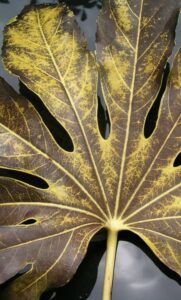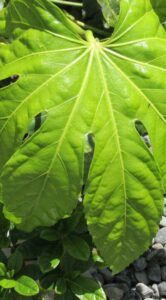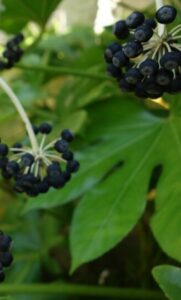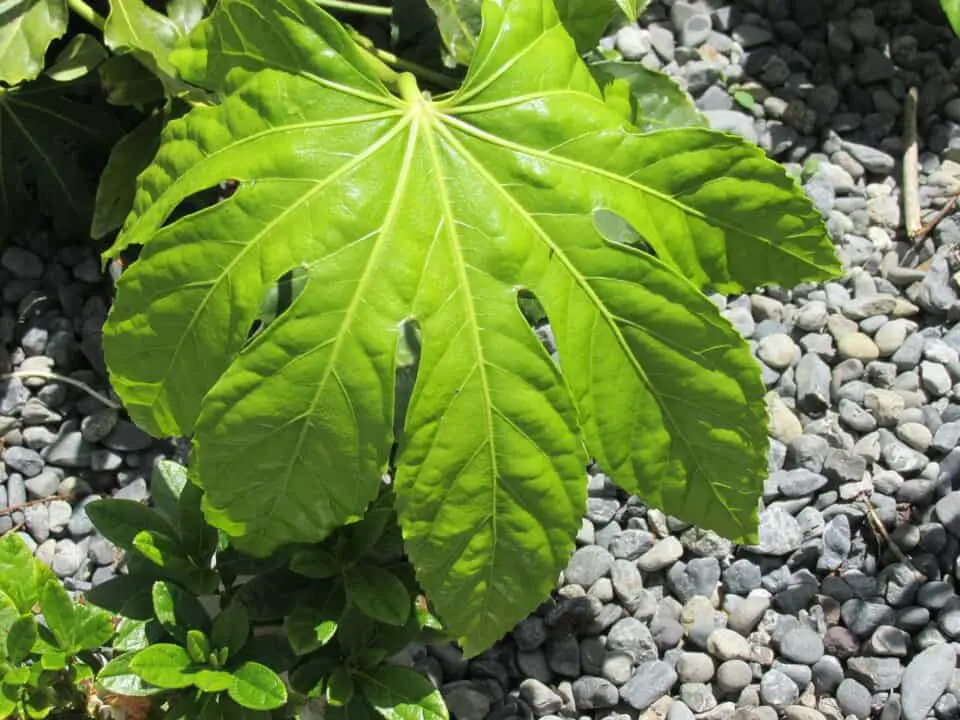Some links in the post are affiliate links and I get a commission from purchases made through some links found in the post.
Fatsia japonica is a plant that is grown indoors as well as outdoors for its beautiful foliage. The plant grows quite rapidly. If your Fascia japonica is facing yellowing, multiple things could go wrong.
The fatsia japonica leaves turning yellow are primarily due to alkaline soil. Alkaline soil inhibits iron absorption, resulting in iron deficiency. Another cause of yellowing foliage in Fatsia japonica is underwatering.
Overwatering can also cause yellowing of the plant if it remains submerged for an extended period. The Fatsia japonica leaves can also turn yellow when exposed to too much sunlight.
The leaves turn yellow due to a lack of Iron. Scales, aphids, mealybugs, or spider mite infestation can create yellow spots on the Fatsia japonica leaves.
For more detail on the causes and learning how to fix yellow leaves in Fatsia japonica, keep on reading!
Why are your Fatsia Japonica Leaves Turning Yellow?
 The Fatsia japonica is also known as a glossy-leaf paper plant or false castor oil plant. Fatsia is adaptable and can be grown in various environments, from shady garden sights to warm sunny outdoor seatings.
The Fatsia japonica is also known as a glossy-leaf paper plant or false castor oil plant. Fatsia is adaptable and can be grown in various environments, from shady garden sights to warm sunny outdoor seatings.
Fatsia prefers room temperatures of 60-75 degrees. It is also effective as a decorative plant, preferably in a friendly, well-ventilated room with no heating systems.
The plant can be grown both indoors and outside. Watering the plant regularly is needed to keep the soil moist at all times.
Also, keep the plant well-watered while it settles in, and then only water in dry conditions.
Container plants should be checked frequently because they can dry out quickly. Fatsia does well when planted in the spring into damp but well-drained, rich soil that has been modified with well-rotted compost or fertilizer.
Fertilize plants growing in the ground after the danger of frost has passed. Annually, apply a tree and shrub fertilizer. In late summer, you can propagate the plant from semi-ripe cuttings.
During the spring and summer, Fatsia can grow very quickly. You can prune it to keep it at a specific size. If you do not do this, it may outgrow its container within six months to a year.
Keep a keen eye on it and repot the plant as necessary to keep it nourished. Fatsia is not a toxic plant, but its sap can cause dermatitis.
Now that you’ve learned more about your Fatsias preferences let’s see why your plant may be turning yellow.
1) Alkaline Soil
When the soil is too alkaline, the leaves of Fatsia japonica turn yellow. That is not to say Fatsia prefers only acidic soils. Fatsia japonica thrives in neutral soils.
Your plant will not be able to absorb Iron if the soil is too alkaline. If the leaves are yellow, but you can still see the veins, the plant is Iron deficient. If the plant is generally yellow, there is something wrong with the soil.
How to fix it
Use a pH meter to test the soil. There are methods for restoring soil alkalinity. You can improve your alkaline soil by adding sequestered Iron. A layer of peat mulch around your Fatsia japonica also helps.
2) Underwatering
Underwatering is most likely the most common cause of Fatsia japonica leaf yellowing. Plant leaves that are not watered turn yellow and crispy.
Fatsia japonica prefers moist but not soggy soil. Plants that are underwatered cannot absorb enough nutrients and thus turn yellow.
How to fix it
Check the soil of your potted Fatsia frequently and keep it moist at all times. Keep a soil moisture meter handy and check the moisture when in doubt.
3) Too much sunlight
Shifting your Fatsia japonica into a bright, sunny location can also cause the leaves to turn yellow. Fatsia thrives in partial shade.
The plant can grow in bright sunlight, but it must be gradually acclimated to the conditions. Sunburn is caused by abruptly moving the plant.
How to fix it
If your Fatsia japonica has been expanding indoors for a long time, gradually acclimate it to weather conditions.
You may also like: 10 most common fatsia japonica problems & how to fix them
4) Low Humidity
Low humidity levels may also lead to yellowing and then browning. Its foliage may begin to brown and clench if the surrounding saturation is too low or the heat is too high, especially in direct sunlight.
How to fix it
Make a humidity pan to provide your plant with a moist and stable environment. Water the foliage down from time to time to keep the leaves hydrated and the dust levels low.
5) Too much sunlight
Yellowing or browning leaves or deformed immature growth are vital signs of plentiful light in a Fatsia kept in a sunny position.
How to fix it
The ideal location is a few meters inside a window or with overhead lighting. However, it would be best to avoid situations of light placement where even a newspaper cannot be read.
It’s because of the increased risk of overwatering and root rot.
6) Fertilizer Burn
 When the plant suffers from fertilizer burn, the leaves of Fatsia japonica turn yellow with brown edges. Fertilizer burn occurs when the soil is overfertilized.
When the plant suffers from fertilizer burn, the leaves of Fatsia japonica turn yellow with brown edges. Fertilizer burn occurs when the soil is overfertilized.
Overfeeding causes salt to accumulate in the soil. This salt buildup prevents your Fatsia Japonica from absorbing essential minerals.
How to fix it
Contact local universities and request soil testing via their low-cost service. Water deeply to flush out excess salts if there is an excess of salt in the soil.
Always thoroughly water your Fatsia japonica before and after feeding it. Wait a month before fertilizing your Fatsia japonica to see if it revives. Don’t over-fertilize the soil and use organic mulch only as the plant requires.
7) Pest Infestation
The most common reason for yellow spots on Fatsia japonica is scale infestation. However, aphids, Mealybugs, and Spider mites can also damage your Fatsia japonica, eventually turning the leaves yellow.
Scales
Scale infestation causes small spots on the leaves of Fatsia japonica. Scales are attached to the undersides of the leaves. Look at the bottoms of the leaves as soon as you notice yellow spots on them.
Scales enjoy sucking the plant sap from the leaves of Fatsia japonica. Scale pests feed on plant juice and expel honeydew.
Honeydew attracts a variety of fungi, resulting in sooty mold. Sooty mold is a black-colored fungal outgrowth on the plant that is unsightly.
Aphids
Aphids are common pests of both indoor and outdoor plants. The leaves of Fatsia japonica are distorted due to aphid infestation.
Affected leaves curl up, providing a safe haven for these troublesome pests. Aphids suck plant sap from the leaves, eventually turning them yellow.
In addition, aphids produce nectar, which attracts sooty mold. Check the curled leaves for pests and treat the plant as soon as you notice honeydew/sooty mold.
Mealybugs
Mealybugs are a type of scale insect that excretes masses of white, spongy material on the plant body. The mealybugs extracts plant sap from the leaves.
They typically appear in the undersides of leaves and close the blossoms. Do not allow the infestation to become out of control.
Spider mites
Spider mites are tiny insects that make webcasts on the host plant. If you notice those webcasts, you can confirm their presence on Fatsia japonica.
In addition, the leaves can turn yellow if they are infested with these spider mites.
How to fix it
Here are a few methods for getting rid of these insects from your Fatsia japonica. To dislodge the insects, forcefully spray water on the affected branches of the plant.
This method works when there are only a few insects on the plant. As soon as you see them, remove them with your hands. This may appear to be a lot of work, but it’s worth it.
8) Natural shedding
Old fatsia leaves turn dry and yellow and shed off in the summer season by themselves. This is a natural process, and nothing can be done to avoid it. Don’t worry because the new leaves will grow back soon.
If the new growth is also yellow, you might want to consider the above reasons, look out for the watering schedule you’re following and place the plant in a place with adequate sunlight.
Final Thoughts
 Fatsia japonica is a beautiful plant that yellows due to alkaline soil, which inhibits iron absorption. Underwatering the plant can also lead to the yellowing of the foliage.
Fatsia japonica is a beautiful plant that yellows due to alkaline soil, which inhibits iron absorption. Underwatering the plant can also lead to the yellowing of the foliage.
Overwatering and remaining submerged underwater for an extended period of time is also detrimental to the plant
Scales, aphids, mealybugs, or spider mite infestation can create yellow spots on the Fatsia japonica leaves.
Using appropriate methods to water the plant, placing it in a proper but not overpowering amount of light, and preventing pest infestation by using neem oil are some of the ways by which you can avoid yellowing.
Some yellowing of the old leaves followed by their shedding is natural and inevitable.
About the Author:
Saad Ansar
Saad is an avid gardener himself and is a great lover of plants, animals, photography, & people. Currently, he is focused on photographing indoor plants & captioning beautiful outdoor sceneries. He writes and rewrites in-depth articles on nature and science.


